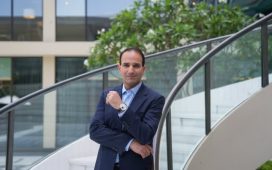The Lloyd’s of London chief executive wants to “get Monday back” and see brokers and underwriters on the trading floor four days a week — in a push to ensure face-to-face trading continues to thrive following the Covid pandemic.
“The building is busy,” said John Neal, CEO of the specialist insurance market made up of about 400 firms and based in central London, at the publication of a full-year trading update on Wednesday.
“Tuesdays, Wednesdays and Thursdays are busy,” he told the Financial Times. “We need to get Monday back.”
A shift to fully digital trading during Covid lockdowns had led to some arguing that the days were numbered for face-to-face trading at Lloyd’s — a centuries-old practice of brokers and insurers agreeing insurance policies at the underwriter’s desk, or “boxes” as they are traditionally called.
That debate has “gone”, Neal said, with face-to-face trading certain to remain as part of the mix alongside virtual dealings. Work is ongoing to see how the building could be redesigned to better suit this hybrid model.
Last year saw some significant insurance events, with Lloyd’s setting aside £1.6bn for claims expected from the war in Ukraine, and £2bn for Hurricane Ian. Despite these, the insurers within the market posted an aggregate combined ratio — claims and expenses as a percentage of premiums — of 91.9 per cent, the best since 2015. Anything below 100 per cent represents an underwriting profit.
Meanwhile, insurance premiums rose by almost a fifth as Lloyd’s pushed through price rises in areas such as property catastrophe, and sought to protect itself against rising inflation.
It ended the year with a £0.8bn loss due to previously disclosed mark-to-market investment losses on its bond holdings, which it expects to be cancelled out in coming years as higher yields feed through to higher investment returns. The numbers are set to be audited before final release in late March.
London-listed Hiscox, one of the market’s biggest insurers but also with a significant retail division, also published its full-year results earlier on Wednesday.
It posted a 90.6 per cent combined ratio, which its chief executive Aki Hussain attributed partly to moves in previous years to demand higher prices for property catastrophe risk, mirroring a remediation programme at Lloyd’s.
In the reinsurance business, Hiscox is now increasing its exposure to natural catastrophes by expanding its property catastrophe cover in North America, where price rises have been sharpest after years of losses and underwriters have begun to demand tougher terms and conditions.
“When other people are pulling out, that is the time to go in,” Hussain said. In the crucial turn-of-the-year policy renewals, the premiums it retains within its reinsurance business rose almost half year on year as it put more capital to work.
Hussain agreed that face-to-face trading at Lloyd’s had survived the pandemic threat. “There is much more electronic or email trading going on, but that is now complementing face to face.”
Hiscox’s London office is now “noisy” between Tuesday and Thursday, and Monday has been increasingly busy, mirrored by its presence at Lloyd’s, he said. “All our senior decision makers are in the room.”
Negotiations are continuing over extending the lease at the iconic Richard Rogers-designed building in London’s insurance district, with Lloyd’s seeking to stay beyond its 2031 lease expiry.











